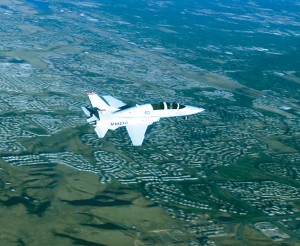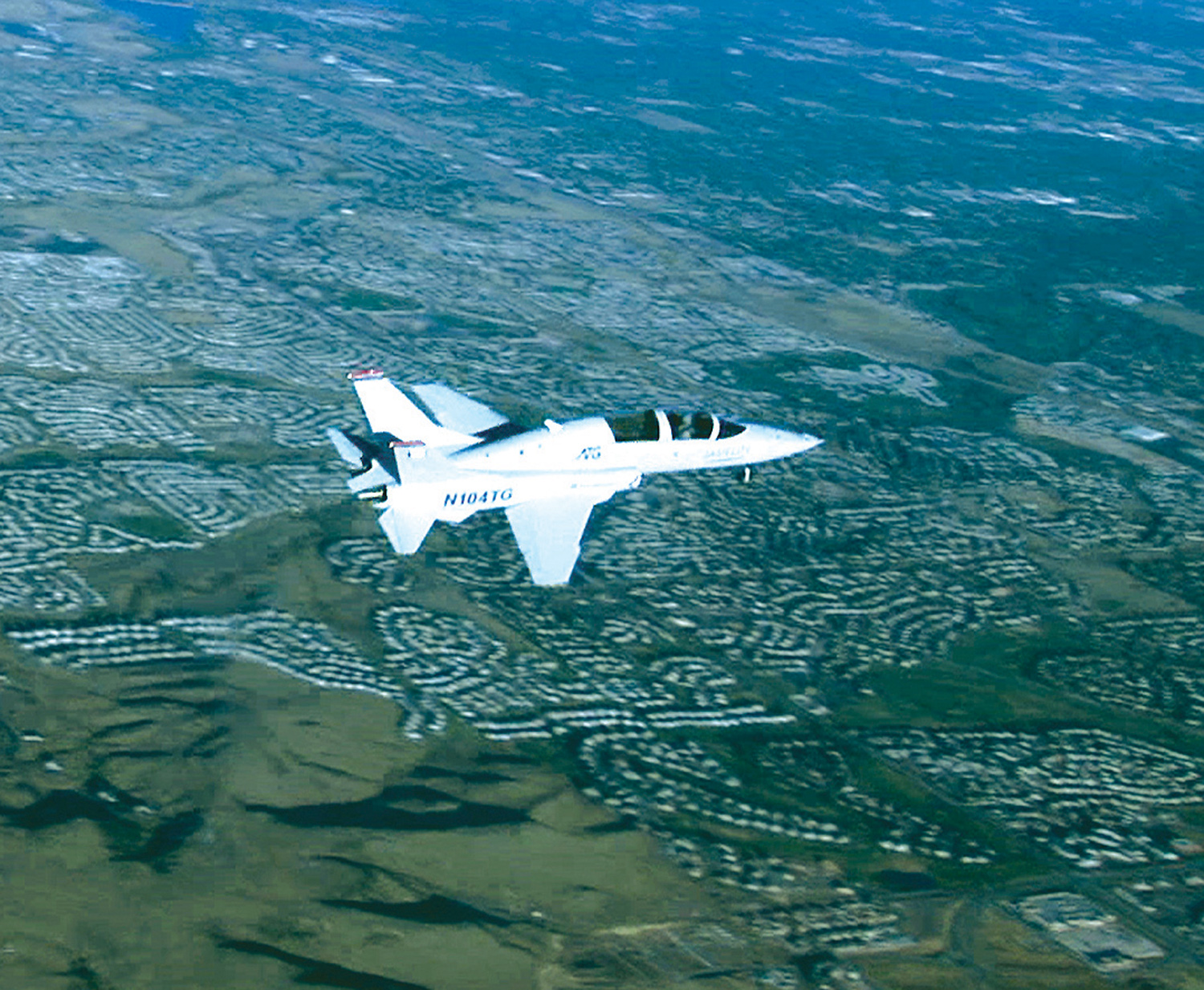By S. Clayton Moore

Aviation Technology Group expects first deliveries by 2008 of the Javelin, a fully-certified production aircraft.
You can now comparison shop for your own personal “fighter jet.” Most hotshot pilots, even those with stick time in World War II fighters, never thought they’d see the day. Even for those owner-operators with the means to buy a personal jet, a subsonic aircraft with military capabilities was out of the question, barring the occasional rogue Russian MiG that came up for sale.
With the development and evolution of our cover-featured aircraft, Colorado-based Aviation Technology Group’s Javelin very light jet, and its lower priced kit plane “cousin,” the Viperjet MkII, even the average businessman can rocket across the high desert with as much thrust as a military pilot flying for the U.S. Air Force.
Admittedly, dramatic differences between the two aircraft become obvious when they’re nose-to-nose. Despite their dramatic divergence in thrust, performance and category, the two aircraft, oddly enough, have connections, rooted in Colorado’s burgeoning aviation industry.
AirBoss Aerospace, a hotdog partnership of conceptual designers owned by Dave Fawcett of Colorado Springs and Mark Bettosini of Reno, Nev., helped design the composite structure of both the Javelin and the Viperjet. The company was also the contract manager for the Javelin prototype that flew successfully in late September.
The Javelin team has now proved their concept is able to fly and Viperjet Aircraft’s Viperjet MkII is already available in kit form. So which jet is right for you? The answer to that question is found, for most aviators, in their personal taste, the depth of their pockets, and their penchant for good old American know-how.
The Javelin
If price is no object, you may want to join the lofty ranks of future Javelin owners like Oracle CEO Larry Ellison, billionaire telecommunications magnate Bruce McCaw and RE/MAX founder Dave Liniger, who will add the Javelin to a personal fleet that already includes a Canadair CT-114 Tutor, a souped-up military version of the type flown by the Snowbirds aerobatic team.
But we’re talking about $2.5 million to get into the Javelin’s state-of-the-art cockpit, at least for the Mk-10, the civilian version. ATG is also developing the Mk-20, a military trainer that will be capable of search and rescue, reconnaissance and light interceptor functions. Yet while reconditioned military aircraft occasionally come available for sale for $500,000 or more, the Javelin won’t be subject to their extensive restrictions.
The civilian version will have plenty of vigor. For the aircraft’s two pilots, the Javelin’s two FADEC-controlled Williams International FJ33-4-17M turbofan engines will combine to produce a thrust-to-weight ratio greater than the supersonic USAF T-38.
One minor drawback: the Javelin isn’t quite ready yet. The jet will be a fully-certified production aircraft, a process ATG expects to complete over the next two years, with first deliveries of the Javelin expected by 2008.
The Javelin is a robust jet, with its pressurized cabin and the ability to reach speeds of 0.925 Mach, heights of 45,000 feet and a maximum range of 1,200 nautical miles. The aircraft is 36 feet long with a wingspan of 23.25 feet, a certified ceiling of 45,000 feet and a rate of climb of 10,000 feet per minute.
With its lightweight turbofan engines and ergonomic design, the Javelin has always been sexy on the outside. Beyond that, the cockpit will integrate the FlightMax Entegra system, comprised of two 10.4 inch diagonal displays that include a primary flight display and a datalink-enabled multi-function display in each of the fore and aft cockpits, as well as an integrated flight management system.
Viperjet
Dan and Scott Hanchette, the brothers behind Pasco, Wash.-based Viper Aircraft Corporation, say the MkII, which definitely looks like a military jet, performs “like you expect a military jet to perform” and “outperforms almost every surplus military jet you can buy on the market today.” But there’s another appealing fact.
“The difference in our airplane and a military aircraft is our wing design and our tail design,” Dan Hanchette said. “You won’t find very many military aircraft that have 77 knot stall speed, yet fly over 500 miles an hour.”
The Viperjet MkII has caught the attention of several high-profile pilots, many who stopped by to see the aircraft at the Reno Air Races, but the Hanchettes are keeping mum about who those pilots are.
Like the Javelin, the Viperjet MkII is a two-seat, fully aerobatic aircraft. It’s a smaller aircraft, 25.5 feet in length with a 30 foot wingspan, and can only carry 100 pounds of baggage to the Javelin’s 200 pounds.
Powered by the GE CJ610/J85, the Viperjet prototype recently exceeded its projected indicated air speed of 325 knots (561 mph true) at 25,000 feet. It’s capable of a very respectable 450 knots or better in the hands of an experienced pilot.
The jet’s 10,000 to 12,000 feet-per-minute climb rate keeps right up with its big brothers and blows nearly every other kit plane right out of the running. It also has a range of 800 to 1,000 nautical miles. Due to many customer requests, Viper Aircraft Corporation also now has a number of pressurized Viperjets that are very near completion.
The Viperjet also gets big points in the price category. A deposit as little as $18,340 secures your serial number and puts you in the queue for planning assistance. The price of the base kit runs a little over $180,000, before selecting the power plant and avionics. The Hanchettes estimate that once your kit is completely built-out, you’ll have spent between $450,000 and $550,000.
The most unusual requirement for getting into a new Viperjet isn’t deep pockets or jet experience; it’s elbow grease. The advanced composite construction makes it a relatively easy build, with 2,000 to 3,500 hours building time over 12 to 18 months. It’s also worth noting that Viperjet has a well-oiled builder assistance program in place.
Both the Javelin and the Viperjet are serious aircraft for serious pilots. One skeptic has remarked that for a sub-par pilot, these kinds of planes are a “sure way into farming.” Still, according to Dan Hanchette, every pilot that has flown the Viperjet was surprised by the ease of flying the jet. Viper Aircraft Corporation does recommend that before climbing into the Viperjet cockpit a pilot have several hundred hours in a Bonanza, Mooney or similarly powered aircraft.
Both companies have planned well in advance to get qualified future pilots up to speed. The Javelin, which requires a type rating, should be a relatively simple learning curve for pilots with a multi-engine rating and 1,500 hours or better. The Javelin course will include ground school, simulator training and some actual flight time in the aircraft, all included in its base price.
Whichever aircraft you choose, you can feel confident that you’re joining the exclusive ranks of America’s amateur jet jockeys. Whether you’re using the Javelin to jet you and your vice president to the coast for a business meeting or simply pushing the envelope over your local airport in the Viperjet MkII, the cool factor for owning one is tremendous. Let’s face it, it’s a couple of million for a business jet anyway. Buzzing the tower in your own fighter-like jet: priceless.











